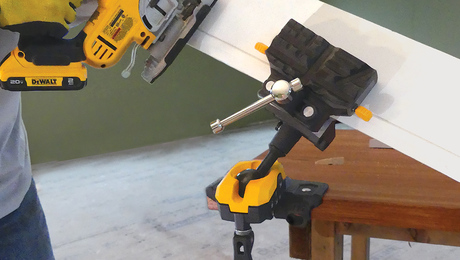Hello All,
In this bottom floor room that we are proposing to finish I need to run the drain lines for the bathroom above and heating ducts for both rooms inside a soffit. I believe that this is a standard use for a soffit. Hide the ugly heating ducts, ABS drain lines and supply plumbing behind a ‘bump out’ in the top corner of a wall. I ran this past one of my inspectors (isn’t it great to get a different inspector every time you call???? Makes for some great continuity…..) and he said something about having to firestop the soffit? I was busy writing down a bunch of his other ‘suggestions’ for improvement and forgot to ask him to clarify this.
How do you ‘firestop’ a soffit full of mechanicals? I don’t see how that’s possible?
Daniel Neuman
Oakland CA
Crazy Home Owner




















Replies
If you're in a detached single family dwelling, you should not have to firestop the soffit.
Actually, in some places you do have to firestop the soffit. They just required us to stuff insulation in the joist spaces allong the soffit so that air could not be sucked through the soffitt into other places in the house. It always seemed like a bunch of hooey to me, but we did it because the inspector wanted us to.
I would contact the inspector (don't worry, I'm sure you'll get yet one more that you haven't talked to before.) And ask them exactly what they require for this.
Keeping on "living and learning"!!
What Mark said in the last post is how they make us do it around here. Stuff with unfaced insulation at every 10' section of soffit. if there is a B-vent running in the soffit they make us pan with tin along with firecaulk.
Are we talking horizintal or vertical "soffit". I know a firestop every 10' in a vertical uninsulated cavity is code here.
Both. When we go vertical they also make us fire stop @ each floor or roof line & every 10'. I would say when going vertical it would be called a chase around here. Soffit would be horizontal. They also make us fire stop where a chase & soffit intersect. If the chase or soffit is open with no pipes in them, they have let us use 5/8" drywall or 3/4" ply to fire stop also.
Check back with inspector/s for clarification. Typically firestopping involves using non combustible materials - steel stud track and drywall would be fine for this one - plus flameproof caulking wherever the mechanicals pierce a wall or ceiling. Nothing too onerous.
You need to put some Thermafiber, it is a rockwool product used a lot commercially.
I believe it is a USG product.
http://www.icc-es.org/reports/pfd_files/UBC/2331.pfd
I believe that Pacific Supply carries it, there is one in west Oakland. If they don't have it, try Westside Supply down by the coliseum.
Do wear a mask when handling it, it is nasty stuff, but pretty harmless once sealed in the walls.
I live in Alameda and I used it in my own remodel in some round soffits after the inspector wanted draftstops in all dropped ceilings. You might ask if regular insulation stuffed tightly would be acceptable as a draftstop, rather than a firestop.
If you interested, Hilti makes all sort of high tech firestop products, but very pricey. Their website should have tons of info.
Mike
Trust in God, but row away from the rocks.
Daniel, here in Michigan we have to "firestop" all soffits. The true techical term that we do is "draftstop". It very simple: we either install blocking in each stud bay slightly below the soffit, or we install a continues layer of sheating on the studded wall, in the soffit area, before we build the soffit. I normally use the latter method.
Heres a picture of a shower ceiling drop that I am building. I install the "firestopping" first.
The plywood prevents a fire from drafting air from adjacent stud bays, if a fire should start in another stud bay. The theory is that a hidden fire will self extiguish if it doesn't get enough oxygen to fuel it.
blue
I guess different jurisdictions use different material and have different requirements for fire stopping. We have to use 3/4" wood or 1/2" drywall. For us, normally, wood is used since that is what is on site when the framer is there. The way the space is firestopped depends somewhat on the configuration, and what is easiest to implement.
See attached pic. For a soffit we are required to either install firestopping in stud bays (1) & ceiling (3), or wall (2) & ceiling (3).
So, the idea is to prevent a fire from "racing" through a structure using conduits formed by "extra framing cavities" such as soffits and chases. These "conduits" connect other normal cavities such as stud bays and joist bays that would normally be isolated by drywall, etc.
Okay I understand now. It seems like the best way in new construction would be to sheath the wall and ceiling behind the soffit.
In a retrofit situation where the water pipes, dwv pipes and heating duct already exist don't see how that would be easily possible....shoot, its always better to do it right the first time.....
Daniel Neuman
Oakland CA
Crazy Home Owner
You have to notch around the pipes.
The whole idea is to prevent the fire from going up the stud bay into the soffit and then traveling horizontally.